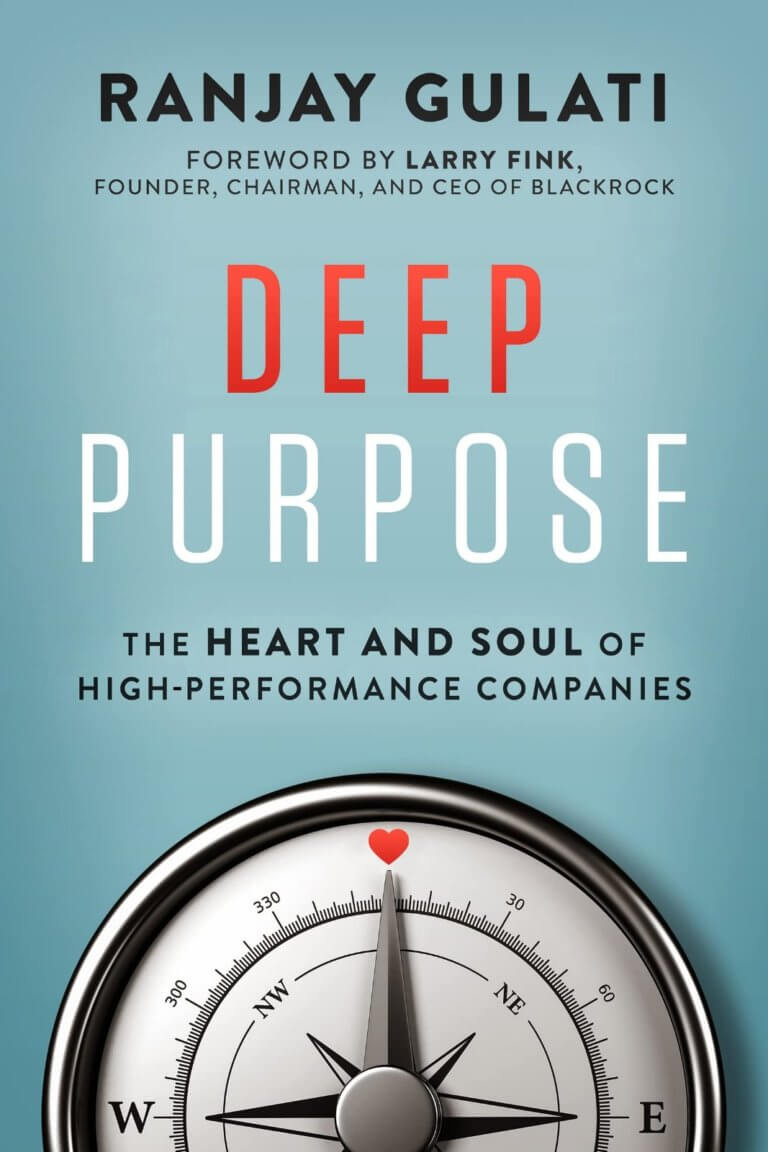In his new book, “Deep Purpose”, Ranjay Gulati uses the time-tested case methodology in unraveling the secret to creating companies that are truly purpose-driven to the core. Now, more than ever, businesses are operating in the most turbulent and volatile settings imaginable, with a long-lasting global pandemic, large-scale political conflicts, and civil and political unrest. These are, indeed, trying times. Ranjay explores some good (and bad) examples of leadership, as well as companies that have tried, succeeded, and/or failed at driving change.
Some key lessons worth noting are:
- Purpose affects performance. Citing an example close to home, Ranjay told the story of how his mother grew her fledgling clothing enterprise from a rural town in India to a larger audience in the Western World. While she never explicitly stated this, it was his understanding that his mother was passionate about sharing the craft of their people to a more global audience and showing them the value of hand-crafted textiles. This led him to revisit his old studies, which showed that corporate initiatives in such areas provided handsome profits.
While scholars did not know yet how to measure purpose per se, as far back as the early 2000s, a review of 95 studies revealed a positive relationship between corporate social performance and financial performance. While the studies are suggestive, these small, fast-growing entrepreneurial ventures can be described as purposeful enterprises. His goal now is to see the application of this hypothesis in large-scale organizations.
- While on the subject of purpose, we must also consider what it isn’t. We now look into his classification of “Convenient Purpose”, which can be classified into three categories.
First, purpose-as-disguise, such as the case of Theranos, founded by Elizabeth Holmes, used lofty language in its mission statement to mask questionable business practices.
Second, purpose on the periphery, where enterprises would adopt a purpose statement and take steps to deliver on it. Such is the case of most CSR (Corporate Social Responsibility) programs, which give corporations a free pass in re-imagining or re-inventing their core businesses, even if the core business is doing more harm than good. These companies aim to give back enough just to maintain a good image to the public.
Third, purpose as win-win, where enterprises would focus only on finding solutions for seeming dilemmas. While this might sound intrinsically better than the previous two examples, focusing only on the intersection of “doing good” by “doing well” is inherently unsustainable in the long term. Forced to choose between financial performance and doing good, leaders of win-win firms would usually side with shareholders in the end.
- My favorite example of creating a deep purpose is by using the “Big Story” concept, an all-encompassing narrative that a company will use to show its vision for the future. One example of this was the story of PepsiCo CEO Indra Nooyi. Shortly after being appointed as CEO in 2006, Nooyi announced that she was re-orienting PepsiCo around a new strategy, called “Performance with Purpose”.
Note that this was a time well before terms like “purpose-driven” have become mainstream. Her goal was to pursue both commercial and social targets for PepsiCo.
Financial targets remained at the forefront of her strategy, which was why performance came before purpose. However, this was underlined with a goal of broad-based purpose, adjusting the company’s portfolio of products and addressing environmental concerns. Nooyi explained that “We have a profound role to play in society and we have to make sure that we are constructive members of society.”
The early stages of this transformation journey were difficult, faced with concerns and criticisms coming from shareholders, employees, suppliers, and even some customers, who thought that the idea was in outright conflict with the essence of PepsiCo. Throughout her tenure, Nooyi promoted the new strategy, speaking about it at any given opportunity, and publicizing it in internal and external communications. She charged all her direct reports with promoting “Performance with Purpose” to their own teams, “It was a complete surround-sound performance.” This was the big story that PepsiCo wanted to promote, “We’ll become a different kind of company in the years ahead, changing our portfolio to make products healthier, and changing our core operations to do social good.”
- The power to make autonomous decisions within large organizations seems like such trivial freedom that is taken for granted. However, as highlighted by the example of Mahindra coming to the aid of local farmers, lending their equipment for free at a time of great turmoil, was exactly on-brand with their purpose.
In the late 1990s, then managing director and now chairman, Anand Mahindra adopted a limited purpose: to show the world that an Indian company could produce world-class products and services. This would then be distilled into a single word, which would capture the essence of “Rise”— challenging conventional thinking and innovatively using all resources to drive positive change in the lives of stakeholders and communities across the world to enable them to rise.
The farm equipment business interpreted “Rise” as a “democratizing technology for small land-holding farmers globally.” This prompted the business unit to create services like “Farming Equipment as a Service”, greatly reducing the need for small farmers to shell out large amounts of money for capital expenditures and giving them access to the latest technology available. More importantly, this empowered Shipra Kumari and the FES unit to help struggling farmers in 2020, at a time when not being able to harvest crops meant famine and poverty in an already challenging year.
To learn about John Clements Consultants’ leadership programs and services, come visit the JC Leadership Institute!




